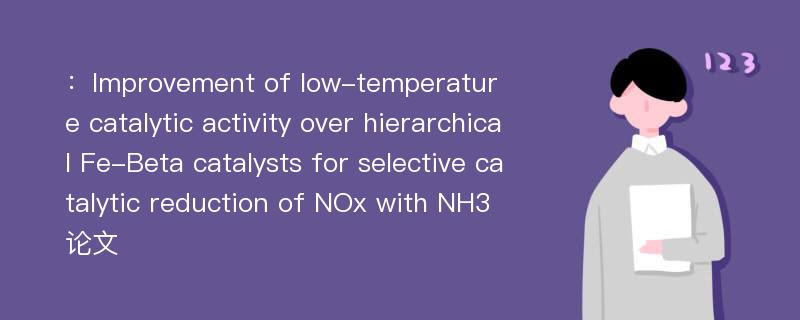
本文主要研究内容
作者(2019)在《Improvement of low-temperature catalytic activity over hierarchical Fe-Beta catalysts for selective catalytic reduction of NOx with NH3》一文中研究指出:Hierarchical Fe-Beta obtained by hydrothermal synthesis exhibited higher low-temperature NH3-SCR activity than conventional Fe-Beta. In order to identify the main factors leading to the difference in catalytic activity, we investigated the pore structure, acidity and Fe sites of the hierarchical Fe-Beta and conventional Fe-Beta. The enhanced activity of hierarchical Fe-Beta was mainly due to the increase of the quantity of active Fe species. NH3-TPD and DRIFTS results of NH3 adsorption clearly verified that hierarchical Fe-Beta had more Lewis acid sites, which is beneficial to the adsorption and activation of NH3. The H2-TPR, UV–vis DRS, and EPR results confirmed that the hierarchical Fe-Beta had more isolated active Fe species, which may be associated with that the hierarchical structure introduced more structural defects as ion-exchange sites. Based on the analysis of kinetics experiments and the abovementioned characterizations, it can be concluded that the improvement of NH3-SCR activity was not due to an intrinsic effect of the specific structural characteristics, but was related to more Fe active sites and better dispersion of Fe species in the hierarchical Fe-Beta.
Abstract
Hierarchical Fe-Beta obtained by hydrothermal synthesis exhibited higher low-temperature NH3-SCR activity than conventional Fe-Beta. In order to identify the main factors leading to the difference in catalytic activity, we investigated the pore structure, acidity and Fe sites of the hierarchical Fe-Beta and conventional Fe-Beta. The enhanced activity of hierarchical Fe-Beta was mainly due to the increase of the quantity of active Fe species. NH3-TPD and DRIFTS results of NH3 adsorption clearly verified that hierarchical Fe-Beta had more Lewis acid sites, which is beneficial to the adsorption and activation of NH3. The H2-TPR, UV–vis DRS, and EPR results confirmed that the hierarchical Fe-Beta had more isolated active Fe species, which may be associated with that the hierarchical structure introduced more structural defects as ion-exchange sites. Based on the analysis of kinetics experiments and the abovementioned characterizations, it can be concluded that the improvement of NH3-SCR activity was not due to an intrinsic effect of the specific structural characteristics, but was related to more Fe active sites and better dispersion of Fe species in the hierarchical Fe-Beta.
论文参考文献
[1].Fabrication of hierarchical polycaprolactone/gel scaffolds via combined 3D bioprinting and electrospinning for tissue engineering[J]. Yong-Ze Yu,Lu-Lu Zheng,Hai-Ping Chen,Wei-Hua Chen,Qing-Xi Hu. Advances in Manufacturing.2014(03)[2].Synthesis and characterization of SBA-15 macrospheres with hierarchical pore structure[J]. Dong Liang,Yan Wang,Jing Hong Ma,Jian Hong Liu,Shu Wei Chen,Rui Feng Li~* Key Laboratory of Coal Science and Technology MOE,College of Chemistry and Chemical Engineering, Taiyuan University of Technology,Taiyuan 030024,China. Chinese Chemical Letters.2009(11)[3].Three-Dimensional Hierarchical Structures of ZnO Nanorods as a Structure Adsorbent for Water Treatment[J]. Zhendong Li,Yingjie Huang,Xingfu Wang,Dan Wang,Xinfu Wang,Fusheng Han. Journal of Materials Science & Technology.2017(08)[4].Hydrogen etching induced hierarchical meso/micro-pore structure with increased active density to boost ORR performance of Fe-N-C catalyst[J]. Liqin Gao,Meiling Xiao,Zhao Jin,Changpeng Liu,Junjie Ge,Wei Xing. Journal of Energy Chemistry.2019(08)[5].Synthesis, characteristics of hierarchical EU-1 zeolite for xylene isomerization probe reaction[J]. Xiaofeng Li,Pengchao Ren,Yanting Zhang,Xiaozhen Liu,Xiaotao Sun,Meng Gao,Miaojuan Jia,Zhiping Lü,Tao Dou. Chinese Journal of Chemical Engineering.2016(11)[6].A Well-defined Hierarchical Hydrogen Bonding Strategy to Polyureas with Simultaneously Improved Strength and Toughness[J]. Ting Li,Tian-Ze Zheng,Zhao-Xia Guo,Jun Xu,Bao-Hua Guo. Chinese Journal of Polymer Science.2019(12)[7].Bio?Derived Hierarchical Multicore–Shell Fe2N?Nanoparticle?Impregnated N?Doped Carbon Nanofiber Bundles: A Host Material for Lithium?/Potassium?Ion Storage[J]. Hongjun Jiang,Ling Huang,Yunhong Wei,Boya Wang,Hao Wu,Yun Zhang,Huakun Liu,Shixue Dou. Nano-Micro Letters.2019(04)[8].One-Pot Synthesis of Hierarchically Nanoporous SSZ-13 for Conversion of Methanol to Olefins[J]. Li Yuping,Wang Yanyue,Zhang Yi,Liu Rui,Li Xiaofeng,Dou Tao. China Petroleum Processing & Petrochemical Technology.2017(03)[9].Preparation of hierarchical mesoporous Zn/HZSM-5 catalyst and its application in MTG reaction[J]. Youming Ni1, Aiming Sun1, Xiaoling Wu1, Guoliang Hai1, Jianglin Hu1, Tao Li1,2, Guangxing Li1,2 1. School of Chemistry & Chemical Engineering, Huazhong University of Science & Technology, Wuhan 430074, Hubei, China; 2. Hubei Key Laboratory of Materials Chemistry & Service Failure, Huazhong University of Science & Technology, Wuhan 430074, Hubei, China. Journal of Natural Gas Chemistry.2011(03)[10].The hierarchical structure of chemical engineering[J]. Mooson KWAUK. Science in China(Series B:Chemistry).2007(01)
论文详细介绍
论文作者分别是来自Chinese Chemical Letters的,发表于刊物Chinese Chemical Letters2019年04期论文,是一篇关于,Chinese Chemical Letters2019年04期论文的文章。本文可供学术参考使用,各位学者可以免费参考阅读下载,文章观点不代表本站观点,资料来自Chinese Chemical Letters2019年04期论文网站,若本站收录的文献无意侵犯了您的著作版权,请联系我们删除。
标签:Chinese Chemical Letters2019年04期论文;
:Improvement of low-temperature catalytic activity over hierarchical Fe-Beta catalysts for selective catalytic reduction of NOx with NH3论文
下载Doc文档
